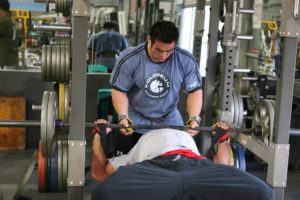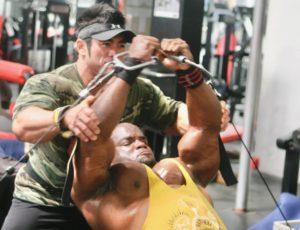
Practical guidelines on this popular training method
By Strength Sensei CP
Publication Date: 1997
I’m often asked about my opinion of forced reps. Short answer: I’m not a fan of how they are commonly performed. Let me tell you why, and then I’ll share with you a method I believe is more effective.
So that we’re on the same page, force reps increase the time a muscle is placed under tension during a set. An example would be performing several reps on the bench press, and when you can’t perform another rep on your own, a training partner will lift up on the bar to give you just enough help to complete the rep.
Here are four mistakes I often see “non-growers” make when performing forced reps:
- Too many forced reps at the end of a set.If you truly work to concentric failure, one or two, at the most three, forced reps are all you can handle. Yet, I see people doing 8-10 forced reps within a set of 12 reps. A good rule to remember is that if your partner is doing more work than you, you should have stopped four reps ago.
- The anticipation of the upcoming forced reps.If you know your training partner will spot you for forced reps, it’s more likely to stop working on the regular reps, and the spotter will start to work too early.
- Horrendous form on forced reps.Performing forced reps takes a considerable skill – on the part of the spotter! If the spotter moves the barbell or dumbbell in a slightly different movement pattern, the training effect is changed.Further, if too heavy a weight is used on forced reps, the spotter may be forced into a compromising posture that could cause injury.
Consider that the goal of forced reps is to prolong the duration of the effort, not make it easier. As Australia’s leading strength coach Ian King said, the forced-rep fiends will select a load “based on their perception of the strength level of their chosen partner.”
 Skilled spotters are needed to perform force reps to ensure the optimal movement pattern of the exercise. (All photos by Miloš Šarčev)
Skilled spotters are needed to perform force reps to ensure the optimal movement pattern of the exercise. (All photos by Miloš Šarčev)
- Adrenal fatigue from high-frequency forced reps.Even though you may enjoy the endorphin high of forced reps, you may also experience adrenal fatigue from high corticosteroid release that, in the end, will stop muscle growth.
As an alternative to traditional forced reps, I prefer this system:
Select a weight you can perform for 4-6 reps. When you finish the last concentric rep, have one or two training partners increase the weight by 10-20 percent. Slowly lower the weight. Now have your training partner(s) help you lift the weight so you can do 1-2 more eccentric reps. Repeat for 2-3 sets. This method can be performed with many free weight exercises but is safer with machines, such as a leg press or leverage shoulder press.
As an alternate to increasing the weight, a training partner can manually apply resistance (i.e., push down on the bar or weight stack) during the eccentric portion. The additional negative repetitions will exhaust eccentric strength levels after you have achieved concentric muscular failure.
 Pressing down on the barbell during a bench press is one practical way to increase the eccentric load.
Pressing down on the barbell during a bench press is one practical way to increase the eccentric load.
Again, I’m not a big fan of traditional forced reps, and believe the two methods I shared with you produce superior results. As Mr. Olympia Franco Columbu used to say, “Forced reps are better done on your own!”
